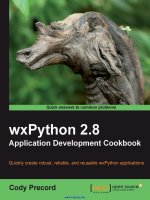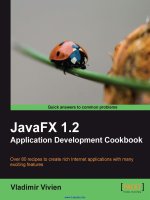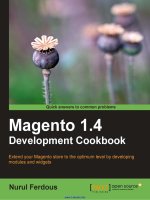odoo development cookbook
Bạn đang xem bản rút gọn của tài liệu. Xem và tải ngay bản đầy đủ của tài liệu tại đây (7.05 MB, 400 trang )
Odoo Development
Cookbook
Build effective applications by applying Odoo development
best practices
Holger Brunn
Alexandre Fayolle
Daniel Reis
BIRMINGHAM - MUMBAI
Odoo Development Cookbook
Copyright © 2016 Packt Publishing
All rights reserved. No part of this book may be reproduced, stored in a retrieval system, or
transmitted in any form or by any means, without the prior written permission of the publisher,
except in the case of brief quotations embedded in critical articles or reviews.
Every effort has been made in the preparation of this book to ensure the accuracy of the
information presented. However, the information contained in this book is sold without
warranty, either express or implied. Neither the authors, nor Packt Publishing, and its dealers
and distributors will be held liable for any damages caused or alleged to be caused directly or
indirectly by this book.
Packt Publishing has endeavored to provide trademark information about all of the companies
and products mentioned in this book by the appropriate use of capitals. However, Packt
Publishing cannot guarantee the accuracy of this information.
First published: April 2016
Production reference: 1260416
Published by Packt Publishing Ltd.
Livery Place
35 Livery Street
Birmingham B3 2PB, UK.
ISBN 978-1-78588-364-4
www.packtpub.com
FM-2
Credits
Authors
Holger Brunn
Project Coordinator
Kinjal Bari
Alexandre Fayolle
Daniel Reis
Reviewers
Guewen Baconnier
Stefan Rijnhart
Acquisition Editor
Manish Nainani
Content Development Editor
Mehvash Fatima
Proofreader
Safis Editing
Indexer
Monica Ajmera Mehta
Production Coordinator
Arvindkumar Gupta
Cover Work
Arvindkumar Gupta
Technical Editors
Menza Mathew
Deepti Tuscano
Copy Editors
Merilyn Pereira
Alpha Singh
FM-3
About the Authors
Holger Brunn has been a fervent open source advocate since he came in to contact
with the open source market sometime in the nineties. With an academic background in
philosophy and sociology, he turned his interest to generalized logic, which proves helpful in
many aspects of his IT work. Turning into a professional programmer was a side effect of his
hobbyist interest, combined with a part-time job with a very open-minded mentor to whom he
owes a lot of gratitude.
He has programmed for ERP and similar systems in different positions since 2001. For the
last eight years, he has dedicated his time to TinyERP, which became OpenERP and evolved
into Odoo. Currently, he works at Therp BV in the Netherlands as a developer and is an active
member of the Odoo Community Association (OCA). He's most interested in fundamental work
on technical modules, but also enjoys contributing to other projects, with a focus on UI and
website widgets, CRM, and knowledge management.
Alexandre Fayolle started working with Linux and free software in the mid 1990s and
quickly became interested in the Python programming language. Between 1999 and 2012, he
helped manage Logilab, a company he cofounded, he specialized in Python development, and
had the opportunity to work on projects for large companies such as EDF, Arcelor-Mittal, and
GdF Suez (now Engie) using the Cubicweb framework.
He also tackled fun projects involving machine learning, natural language processing, and
multi-agent systems. In 2012, he joined Camptocamp to share his expertise on Python,
PostgreSQL, and Linux with the team implementing Odoo (OpenERP at the time). He
currently manages projects for Camptocamp and is strongly involved in the Odoo Community
Association. In his spare time, he likes to play the vibraphone in a jazz quartet, but has
recently been known for writing a book about Odoo, which he hopes you'll enjoy.
FM-4
Daniel Reis has been working in the IT industry for over 15 years in developer, consultant,
and management roles. Most of this work was at the Capgemini multinational consultancy
firm, implementing proprietary business solutions for reference companies in a variety of
sectors, such as industry, telecommunications, and banking. Daniel has a BSc in applied
mathematics and a master's in business administration from the ISCTE Business School.
He's worked with Odoo solutions (formerly OpenERP) since 2010, and he is an active
contributor in the Odoo community association projects. He has been a speaker at the Open
Days annual conference and other open source events. He is the author of the first Odoo
development book: Odoo Development Essentials, also by Packt Publishing.
He currently works at Securitas, the global security services company, where he has
introduced Python, Odoo, and other open source solutions into the company's IT
applications portfolio.
I thank my wife, Maria José, for all the support and patience that made this
book possible.
FM-5
About the Reviewers
Guewen Baconnier is a discrete guy who does not enjoy being put forward. He works
at Camptocamp where he's been a TinyERP programmer before moving to OpenERP and
now Odoo. He is a free software enthusiast and an active member of the Odoo Community
Association (OCA), where his responsibilities involve, among others, being the lead developer
of the OCA Connector Framework. Guewen also loves books so should you come across him,
there is a good chance he may have his nose in one, either reading a technical book to keep up
with his boundless curiosity and hunger to learn, or reading a novel to journey in some fictional
universe, or whatever good read fell into his hands. He likes to hike in the countryside with his
beloved wife. He is also the happy father of two nice kids, with whom he enjoys spending time,
strolling, going to the library, reading books, and playing Kerbal Space Program.
I would like to thank my wife and kids for supporting my tiredness on the
morrows of long evenings of reviewing. And I would like to thank Alexandre
Fayolle who helped me shape this short biography. Finally, thanks to my
colleagues and to all contributors of the OCA from whom I learn every day.
Stefan Rijnhart is a life-long open source advocate and has been a full time Odoo
consultant and developer since 2010. He enjoys collaborating in the Odoo Community
Association (OCA), which he finds to be mutually beneficial to his customers' projects. In the
OCA, Stefan played a key role in the creation of the OpenUpgrade migration project for Odoo
and in the Odoo Community Backports project (OCB). Offline, you can find him riding a carrier
bicycle through the streets of Amsterdam with his son on the front seat, or playing music with
his band. Get in touch with Stefan at terdam.
FM-6
www.PacktPub.com
eBooks, discount offers, and more
Did you know that Packt offers eBook versions of every book published, with PDF and ePub
files available? You can upgrade to the eBook version at www.PacktPub.com and as a print
book customer, you are entitled to a discount on the eBook copy. Get in touch with us at
for more details.
At www.PacktPub.com, you can also read a collection of free technical articles, sign up
for a range of free newsletters and receive exclusive discounts and offers on Packt books
and eBooks.
TM
/>
Do you need instant solutions to your IT questions? PacktLib is Packt's online digital book
library. Here, you can search, access, and read Packt's entire library of books.
Why subscribe?
ff
Fully searchable across every book published by Packt
ff
Copy and paste, print, and bookmark content
ff
On demand and accessible via a web browser
FM-7
Table of Contents
Prefacevii
Chapter 1: Installing the Odoo Development Environment
1
Introduction1
Easy installation of Odoo from source
2
Managing Odoo environments using the start command
9
Managing Odoo server databases
10
Storing the instance configuration in a file
19
Activating the Odoo developer tools
22
Updating Odoo from source
25
Chapter 2: Managing Odoo Server Instances
29
Chapter 3: Creating Odoo Modules
47
Introduction29
Configuring the addons path
30
Updating the addon modules list
31
Standardizing your instance directory layout
33
Installing and upgrading local addon modules
36
Installing addon modules from GitHub
40
Applying changes to addons
42
Applying and trying proposed pull requests
43
Introduction
Creating and installing a new addon module
Completing the addon module manifest
Organizing the addon module file structure
Adding models
Adding Menu Items and Views
Using scaffold to create a module
47
48
49
52
55
57
61
i
Table of Contents
Chapter 4: Application Models
63
Chapter 5: Basic Server Side Development
95
Introduction
Defining the Model representation and order
Adding data fields to a model
Using a float field with configurable precision
Adding a monetary field to a Model
Adding relational fields to a Model
Adding a hierarchy to a Model
Adding constraint validations to a Model
Adding computed fields to a Model
Exposing Related fields stored in other models
Adding dynamic relations using Reference fields
Adding features to a Model using inheritance
Using Abstract Models for reusable Model features
Using Delegation inheritance to copy features to another Model
63
64
66
71
73
74
78
80
82
85
86
87
89
91
Introduction95
Defining model methods and use the API decorators
96
Reporting errors to the user
99
Obtaining an empty recordset for a different model
101
Creating new records
102
Updating values of recordset records
104
Searching for records
107
Combining recordsets
109
Filtering recordsets
110
Traversing recordset relations
112
Extending the business logic defined in a Model
114
Extending write() and create()
117
Customizing how records are searched
120
Chapter 6: Advanced Server Side Development Techniques
125
Introduction125
Change the user performing an action
126
Call a method with a modified context
128
Execute raw SQL queries
130
Write a wizard to guide the user
133
Define onchange methods
138
Call onchange methods on the server side
141
Port old API code to the new API
143
ii
Table of Contents
Chapter 7: Debugging and Automated Testing
153
Chapter 8: Backend Views
179
Chapter 9: Module Data
219
Chapter 10: Access Security
233
Introduction
Producing server logs to help debug methods
Using the Odoo shell to interactively call methods
Using the Python debugger to trace method execution
Writing tests for your module using YAML
Writing tests for your module using Python unit tests
Running server tests
Using the Odoo Community Association maintainer quality tools
153
153
157
159
164
168
172
173
Introduction180
Adding a menu item and window action
180
Having an action open a specific view
184
Adding content and widgets to a form view
186
Adding buttons to forms
189
Passing parameters to forms and actions: Context
190
Defining filters on record lists: Domain
193
List views
196
Search views
198
Changing existing views: View inheritance
201
Document-style forms
205
Dynamic form elements using attrs
207
Embedded views
207
Kanban views
209
Show kanban cards in columns according to their state
211
Calendar views
212
Graph and pivot views
213
QWeb reports
215
Introduction219
Using external IDs and namespaces
219
Loading data using XML files
221
Using the noupdate and forcecreate flags
224
Loading data using CSV files
226
Loading data using YAML files
228
Addon updates and data migration
229
Create security groups and assign them to users
Add security access to models
233
238
iii
Table of Contents
Limit access to fields in models
Limit record access using record rules
Using security group to activate features
241
243
246
Chapter 11: Internationalization
253
Chapter 12: Automation and Workflows
269
Chapter 13: Web Server Development
295
Chapter 14: CMS Website Development
311
Chapter 15: Web Client Development
325
Installing a language and configure user preferences
Configure language-related settings
Translate texts through the web client user interface
Exporting translation strings to a file
Use gettext tools to ease translations
Import translation files
Introduction
Using Kanban stages and features
Creating server actions
Adding messaging and tracking features
Using Python code server actions
Using automated actions on time conditions
Using automated actions on event conditions
Inspecting built-in workflows
253
257
258
261
264
266
269
270
273
276
281
283
288
291
Introduction295
Make a path accessible from the network
295
Restrict access to web accessible paths
300
Consume parameters passed to your handlers
302
Modify an existing handler
304
Using the RPC API
307
Introduction
Extending CSS and JavaScript for the website
Creating or modifying templates - QWeb
Offering snippets to the user
Introduction
Creating custom widgets
Using client-side QWeb templates
Making RPC calls to the server
Writing tests for client side code
Debugging your client side code
iv
311
311
314
318
325
325
331
333
336
340
Table of Contents
Chapter 16: Server Deployment
345
Index
371
Introduction
Installing Odoo for production
Adapting the configuration file for production
Set up Odoo as a system service
Configure a reverse proxy and SSL
Use buildout for repeatable builds
345
345
351
355
357
362
v
Preface
Odoo, formerly known as OpenERP, is a great platform for developers. The framework at
its core is very rich and allows building client–server applications from scratch as well as
adapting existing applications to your needs through a clever extension mechanism and a
very modular design. The latest versions have brought a wealth of new possibilities with the
addition of a full-featured website development stack. The scope is huge and it is easy for
newcomers to feel lost.
For years, Odoo developers have been learning their craft by reading the code of the addon
modules, which are built on top of the framework to provide enterprise management features.
While effective, the process is long and error prone, since it is difficult to know whether the
source code you are learning from is using the latest possibilities offered by the framework,
or if you are looking at an older module that has not been updated to use these features. To
make things worse, some code flows are intrinsically hard to follow because they're partly in
the business logic layer, partly in the database layer, partly in the request handling layer, and
partly in the client side code. The introduction of a new API in version 8 has made things even
more confusing, since most of the code base was not immediately ported to this new API.
This book is meant to save you time by tapping in to the years of experience accumulated
by long-time Odoo contributors to learn the current best practices in Odoo development by
focusing on the new features of version 9, and also giving a solid base in the existing mature
functionality of the framework. Since Odoo has a long tradition of guaranteeing backward
compatibility, most of the presented material should still work with the upcoming versions.
What this book covers
This book contains 16 chapters. We tried hard to make each chapter as independent as
possible, and to make the various recipes in each chapter self-contained.
Chapter 1, Installing the Odoo Development Environment, explains how to create a
development environment for Odoo, start Odoo, create a configuration file, and activate
the developer tools of Odoo.
vii
Preface
Chapter 2, Managing Odoo Server Instances, is about addon installation and upgrading.
It provides useful tips for working with addons installed from GitHub, and organizing the
source code of your instance.
Chapter 3, Creating Odoo Modules, explains the structure of an Odoo addon module and
gives a step-by-step guide for creating a simple module from scratch.
Chapter 4, Application Models, focuses on Odoo model descriptions, and explains the various
field types and the different inheritance models available in Odoo.
Chapter 5, Basic Server Side Development, introduces the v8 API of Odoo, presents the
commonly used methods of the Model class, and explains how to write business logic methods.
Chapter 6, Advanced Server Side Development Techniques, deals with more advanced topics
useful when writing business methods such as writing wizards to walk the user through a
process or writing onchange methods. It also covers porting code from the old API to the
v8 API.
Chapter 7, Debugging and Automated Testing, proposes some strategies for server-side
debugging and an introduction to the Python debugger. It also explains how to write and
run automated tests using YAML or Python for your addon modules.
Chapter 8, Backend Views, explains how to write business views for your data models and how
to call server-side methods from these views. It covers the usual views (list view, form view,
and search view) as well as the views introduced in recent versions of Odoo (Kanban, graph,
calendar, pivot, and so on)
Chapter 9, Module Data, shows how to ship data along with the code of your module. It also
explains how to write a migration script when a data model provided by an addon is modified
in a new release.
Chapter 10, Access Security, explains how to control who has access to what in your Odoo
instance, by creating security groups, writing access control lists to define what operations are
available to each group on a given model, and, if necessary, by writing record level rules.
Chapter 11, Internationalization, deals with the translation of the user interfaces of your addons.
Chapter 12, Automation and Workflows, illustrates the different tools available in Odoo to
implement business process for your records. It also shows how server actions and automated
rules can be used to support business rules.
Chapter 13, Web Server Development, deals with the core of the web server in Odoo. It
explains how to map URLs to methods and how to control who can access these URLs.
Chapter 14, CMS Website Development, shows how to customize websites built with Odoo, by
writing your own templates and providing new snippets for use in the website builder.
viii
Preface
Chapter 15, Web Client Development, dives into the JavaScript part of Odoo and explains
how you can provide new widgets and make RPC calls to the server. It also gives tips about
debugging and testing this part of your code.
Chapter 16, Server Deployment, provides advice on how to install and configure Odoo for
production, including setting up a reverse proxy to encrypt network communications over
HTTPS and ensuring that Odoo starts when the server boots.
Who this book is for
This book is targeted at Python developers who want to learn Odoo development or
consolidate their Odoo skills. Some experience with the JavaScript programming language
and web development in general is required to fully benefit from the frontend chapters.
This book focuses on core application development. It does not cover how to use the business
applications provided by Odoo. You may want to refer to Working with Odoo, by Greg Moss,
for this.
This book does not provide explanations about how the internals of the enterprise
management applications work. To understand this, you will have to read the source code and
experiment for yourself. Being familiar with the contents of the Odoo Development Cookbook
should make your life easier, as it contains pointers to parts of the code you can read to learn
about a specific topic.
What you need for this book
The set up recipes in Chapter 1, Installing the Odoo Development Environment, and Chapter 15,
Web Client Development, expect that you are working on a server running Debian GNU/Linux, or
a derivative distribution such as Ubuntu, in a reasonably up-to-date release. If you are running
another distribution, things should be fairly straightforward; the main differences should be
in the names of the packages to install, and possibly the location of the configuration files of
PostgreSQL and Nginx.
If your workstation is running Windows or MacOS, we advise you to set up a Debian virtual
machine to work with Odoo. While it is possible to develop natively on Windows or Mac, having
a development environment as close as possible to the deployment environment is a good way
to avoid nasty surprises and GNU/Linux is the recommended deployment platform for Odoo.
ix
Preface
Is there a recommended Integrated Development Environment (IDE) for Odoo? This is a
frequently asked question by newcomers. The best answer is to use whatever tool you
are familiar with. Popular choices include Eclipse or PyCharm, but a very high number of
experimented developers, including the core Odoo developers, use just a programming
text editor such as vim, GNU emacs, or Sublime Text to have syntax highlighting and useful
helpers such as automatic indentation, while using the Python debugger for debugging. It is
recommended to start with the basic tools because IDEs have a tendency to hide complexity
you should be familiar with in order to fix the harder problems.
Sections
In this book, you will find several headings that appear frequently (Getting ready, How to do it,
How it works, There's more, and See also).
To give clear instructions on how to complete a recipe, we use these sections as follows:
Getting ready
This section tells you what to expect in the recipe, and describes how to set up any software or
any preliminary settings required for the recipe.
How to do it…
This section contains the steps required to follow the recipe.
How it works…
This section usually consists of a detailed explanation of what happened in the previous section.
There's more…
This section consists of additional information about the recipe in order to make the reader
more knowledgeable about the recipe.
See also
This section provides helpful links to other useful information for the recipe.
x
Preface
Conventions
In this book, you will find a number of text styles that distinguish between different kinds of
information. Here are some examples of these styles and an explanation of their meaning.
Code words in text, database table names, folder names, filenames, file extensions,
pathnames, dummy URLs, user input, and Twitter handles are shown as follows: "The parsing
of the configuration file by Odoo is done using the Python ConfigParser module."
A block of code is set as follows:
[DEFAULT]
project = /home/odoo/projects/project1
env = dev
prefix = %(project)s/%(env)s
[options]
addons-path = %(prefix)s/odoo/addons,%(prefix)s/OCA/server-tools
data_dir = %(prefix)s/data_dir
When we wish to draw your attention to a particular part of a code block, the relevant lines or
items are set in bold:
{
'name': 'Chapter 03 code',
'depends': ['base', 'decimal_precision],
'data': ['views/library_book.xml'] }
Any command-line input or output is written as follows:
$ sudo apt-get install git python2.7 postgresql nano python-virtualenv
New terms and important words are shown in bold. Words that you see on the screen,
for example, in menus or dialog boxes, appear in the text like this: "Click on the Manage
Databases link."
Warnings or important notes appear in a box like this.
Tips and tricks appear like this.
xi
Preface
Reader feedback
Feedback from our readers is always welcome. Let us know what you think about this book—
what you liked or disliked. Reader feedback is important for us as it helps us develop titles
that you will really get the most out of.
To send us general feedback, simply e-mail , and mention the
book's title in the subject of your message.
If there is a topic that you have expertise in and you are interested in either writing or
contributing to a book, see our author guide at www.packtpub.com/authors.
Customer support
Now that you are the proud owner of a Packt book, we have a number of things to help you to
get the most from your purchase.
Downloading the example code
You can download the example code files for this book from your account at http://www.
packtpub.com. If you purchased this book elsewhere, you can visit ktpub.
com/support and register to have the files e-mailed directly to you.
You can download the code files by following these steps:
1. Log in or register to our website using your e-mail address and password.
2. Hover the mouse pointer on the SUPPORT tab at the top.
3. Click on Code Downloads & Errata.
4. Enter the name of the book in the Search box.
5. Select the book for which you're looking to download the code files.
6. Choose from the drop-down menu where you purchased this book from.
7. Click on Code Download.
You can also download the code files by clicking on the Code Files button on the book's
webpage at the Packt Publishing website. This page can be accessed by entering the book's
name in the Search box. Please note that you need to be logged in to your Packt account.
xii
Preface
Once the file is downloaded, please make sure that you unzip or extract the folder using the
latest version of:
ff
WinRAR / 7-Zip for Windows
ff
Zipeg / iZip / UnRarX for Mac
ff
7-Zip / PeaZip for Linux
Downloading the color images of this book
We also provide you with a PDF file that has color images of the screenshots/diagrams used
in this book. The color images will help you better understand the changes in the output.
You can download this file from />downloads/Bookname_ColorImages.pdf.
Errata
Although we have taken every care to ensure the accuracy of our content, mistakes do
happen. If you find a mistake in one of our books—maybe a mistake in the text or the code—
we would be grateful if you could report this to us. By doing so, you can save other readers
from frustration and help us improve subsequent versions of this book. If you find any errata,
please report them by visiting selecting
your book, clicking on the Errata Submission Form link, and entering the details of your
errata. Once your errata are verified, your submission will be accepted and the errata will
be uploaded to our website or added to any list of existing errata under the Errata section
of that title.
To view the previously submitted errata, go to />content/support and enter the name of the book in the search field. The required
information will appear under the Errata section.
Piracy
Piracy of copyrighted material on the Internet is an ongoing problem across all media. At
Packt, we take the protection of our copyright and licenses very seriously. If you come across
any illegal copies of our works in any form on the Internet, please provide us with the location
address or website name immediately so that we can pursue a remedy.
Please contact us at with a link to the suspected pirated material.
We appreciate your help in protecting our authors and our ability to bring you valuable content.
xiii
Preface
Questions
If you have a problem with any aspect of this book, you can contact us at
, and we will do our best to address the problem.
xiv
1
Installing the
Odoo Development
Environment
In this chapter, we will cover the following topics:
ff
Easy installation of Odoo from source
ff
Managing Odoo environments using the start command
ff
Managing Odoo server databases
ff
Storing the instance configuration in a file
ff
Activating the Odoo developer tools
ff
Updating Odoo from source
Introduction
There are lots of ways to set up an Odoo development environment. This chapter proposes
one of these, although you will certainly find a number of other tutorials on the web explaining
other approaches. Keep in mind that this chapter is about a development environment, which
has different requirements from a production environment, covered in Chapter 16, Server
Deployment.
1
Installing the Odoo Development Environment
Easy installation of Odoo from source
For Odoo deployment, it is recommended to use a GNU/Linux environment. You may be
more at ease using Microsoft Windows or Mac OS X, but the fact is that most of the Odoo
developers are using GNU/Linux and you are much more likely to get support from the
community for OS-level issues happening on GNU/Linux than on Windows.
It is also recommended to develop using the same environment (same distribution, same
version) as the one which will be used in production. This will avoid nasty surprises such as
discovering on the day of deployment that some library has a different version than expected,
with a slightly different and incompatible behavior. If your workstation is using a different OS,
a good approach is to set up a virtual machine on your workstation and to install a GNU/Linux
distribution in the VM.
To avoid copying files between your workstation where you are running
your development environment and the virtual machine which runs Odoo,
you can configure a SAMBA share inside the virtual machine and store the
source code there. You can then mount the share on your workstation in
order to edit the files easily.
This book assumes you are running Debian GNU/Linux as its stable version (Jessie at the time
of writing). Ubuntu is another popular choice, and since it is built on top of Debian, most of
the examples in this book should work unchanged. Whatever Linux distribution you choose,
you should have some notion of how to use it from the command line, and having a few ideas
about system administration will certainly not cause any harm.
Getting ready
We assume that Linux is up and running and that you have an account with root access, either
because you know the root password or because sudo has been configured. In the following
pages, we will be using $(whoami) whenever the login of your work user is required in a
command line. This is a shell command which will substitute your login in the command you
are typing.
Some operations will definitely be easier if you have a GitHub account. Go to
and create one if you don't have one already.
How to do it...
To install Odoo from source, you need to follow these steps:
1. Run the following commands to install the main dependencies:
$ sudo apt-get install git python2.7 postgresql nano \
python-virtualenv
2









